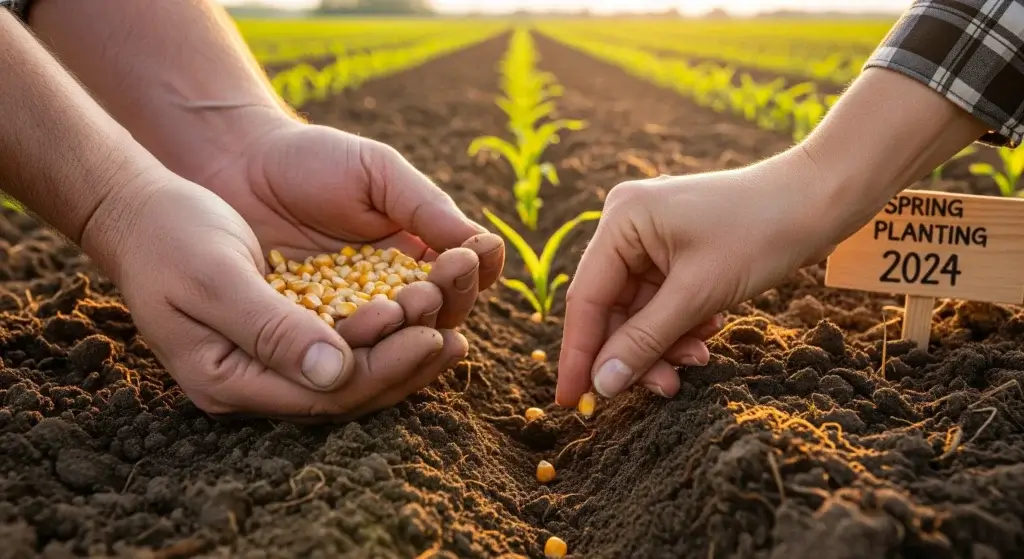
In the pursuit of a vibrant garden, the soil you choose is pivotal. The debate between topsoil and garden soil takes center stage.
This guide dives into the nuances, helping you make informed decisions for your green haven.
Unraveling the distinctions between the two, we equip you with the knowledge to create an optimal growing environment for your plants.
Whether you’re a seasoned gardener or a beginner, this guide is your go-to resource for navigating the world of soils and ensuring your garden thrives from the ground up.
What is Topsoil?
Beginning with the fundamentals, topsoil represents the uppermost layer of soil, usually spanning the initial 5 to 12 inches.
This layer is crucial as it hosts the majority of plant roots.
Comprising a nutrient-rich mix of minerals, organic matter, and microorganisms, topsoil creates an optimal environment for robust plant growth.
It serves as the vital foundation where the intricate dance of roots, nutrients, and life-sustaining elements unfolds, nurturing the flourishing ecosystem of your garden.
- Read also: How to Make Organic Fertilizers at Home
- Read also: How to Use Soil Conditioner

What is Garden Soil?
In contrast to topsoil, garden soil is a finely tuned and personalized concoction.
Typically combining topsoil, compost, and various amendments, its purpose is to create an environment that maximizes the potential for plant flourishing.
The emphasis lies in providing essential nutrients, effective drainage, and optimal aeration.
This refined blend caters to the specific needs of plants, offering a nurtured and bespoke foundation for their growth and vitality.
Difference Between Topsoil and Garden Soil
| Feature | Topsoil | Garden Soil |
| Composition | Natural upper layer of soil | Tailored blend of topsoil, compost, and amendments |
| Nutrient Content | Contains basic nutrients; may lack specific elements | Enriched with nutrients for optimal plant nutrition |
| Organic Matter | Variable organic content depending on location | Typically includes compost for increased organic matter |
| Purpose | Suitable as a base layer for gardens or lawns | Customized for specific gardening needs |
| Structure | General structure with varying fertility levels | Improved structure for better plant support |
When to Use Topsoil and Garden Soil

Topsoil
New gardens or lawns
When starting fresh with a new garden or lawn, topsoil becomes the foundational layer.
Its rich composition of minerals, organic matter, and microorganisms provides an ideal setting for young plants or grass to establish their roots and thrive.
Leveling and filling
Topsoil is your go-to solution for addressing uneven terrain or low spots in your yard.
Its versatility allows it to seamlessly fill gaps, level surfaces, and create a uniform foundation for a well-balanced landscape.
Garden soil
Planting Beds
Garden soil is tailor-made for planting beds, especially in raised beds or directly in the ground.
Its refined blend of topsoil, compost, and amendments creates a nutrient-rich haven for plants.
This specialized environment supports robust growth and ensures the well-being of your garden.
Container gardening
For potted plants, the balanced mix of nutrients and aeration in garden soil is ideal.
Container gardening demands a soil blend that not only provides essential nutrients but also allows for proper drainage and airflow, fostering a healthy environment for plants thriving in confined spaces.
How to Turn Topsoil into Garden Soil
Converting topsoil into a nutrient-rich garden soil involves a simple yet essential process:
Add compost
Introduce well-decomposed compost to the topsoil.
This step enhances the organic matter content, fostering a nutrient-rich environment and improving overall soil structure.
Compost acts as a natural booster, infusing vitality into the soil for optimal plant growth.
Incorporate amendments
Enhance the soil’s properties by incorporating suitable amendments like perlite or vermiculite.
These additions contribute to improved drainage and aeration, crucial factors for creating a balanced and well-aerated garden soil.
The goal is to optimize the soil’s physical structure, ensuring it provides an ideal habitat for plant roots.
Balancing pH
Test the soil’s pH and make necessary adjustments.
If the pH is too high, add lime to raise it; if too low, incorporate sulfur to lower it.
Achieving the right pH level is pivotal as it influences nutrient availability to plants, ensuring they receive the nourishment required for healthy growth.
Fertilize appropriately
Tailor the soil’s nutrient content by incorporating a balanced fertilizer based on the specific needs of your plants.
Choose a fertilizer that provides essential nutrients, promoting robust growth.
This step ensures that your garden soil is fortified with the necessary elements for plant vitality.
Mix thoroughly
Achieve a harmonious blend by thoroughly mixing all added components with the topsoil.
Uniform distribution of compost, amendments, and fertilizer throughout the topsoil guarantees consistent and enriched garden soil.
This meticulous mixing process sets the stage for a balanced and nurturing foundation for your plants.
- Read also: Different Types of Drip Irrigation Emitters
- Read also: Drip Irrigation for Tomatoes

Conclusion
In the ongoing topsoil vs. garden soil debate, the victor hinges on your gardening objectives.
Topsoil takes center stage as the foundational layer, while garden soil emerges as the tailored solution for fostering vibrant plant growth.
Whether you’re reshaping your backyard terrain or cultivating a verdant oasis, grasping the distinctions empowers you to make informed decisions and select the right soil for your specific gardening needs.
Understanding the unique roles of topsoil and garden soil ensures that your gardening endeavors thrive from the ground up.
FAQs
While garden soil contains topsoil, it’s best used for specific planting needs. For foundational layers, pure topsoil may be more suitable.
Amend topsoil in the early spring or fall, giving the soil time to integrate amendments before the growing season.
Yes, combining the two can create a balanced blend. Adjust the ratio based on your specific gardening requirements.
Garden soil often includes fertilizer, but additional fertilizer may be necessary depending on your plant’s needs. Test the soil and fertilize it accordingly.



